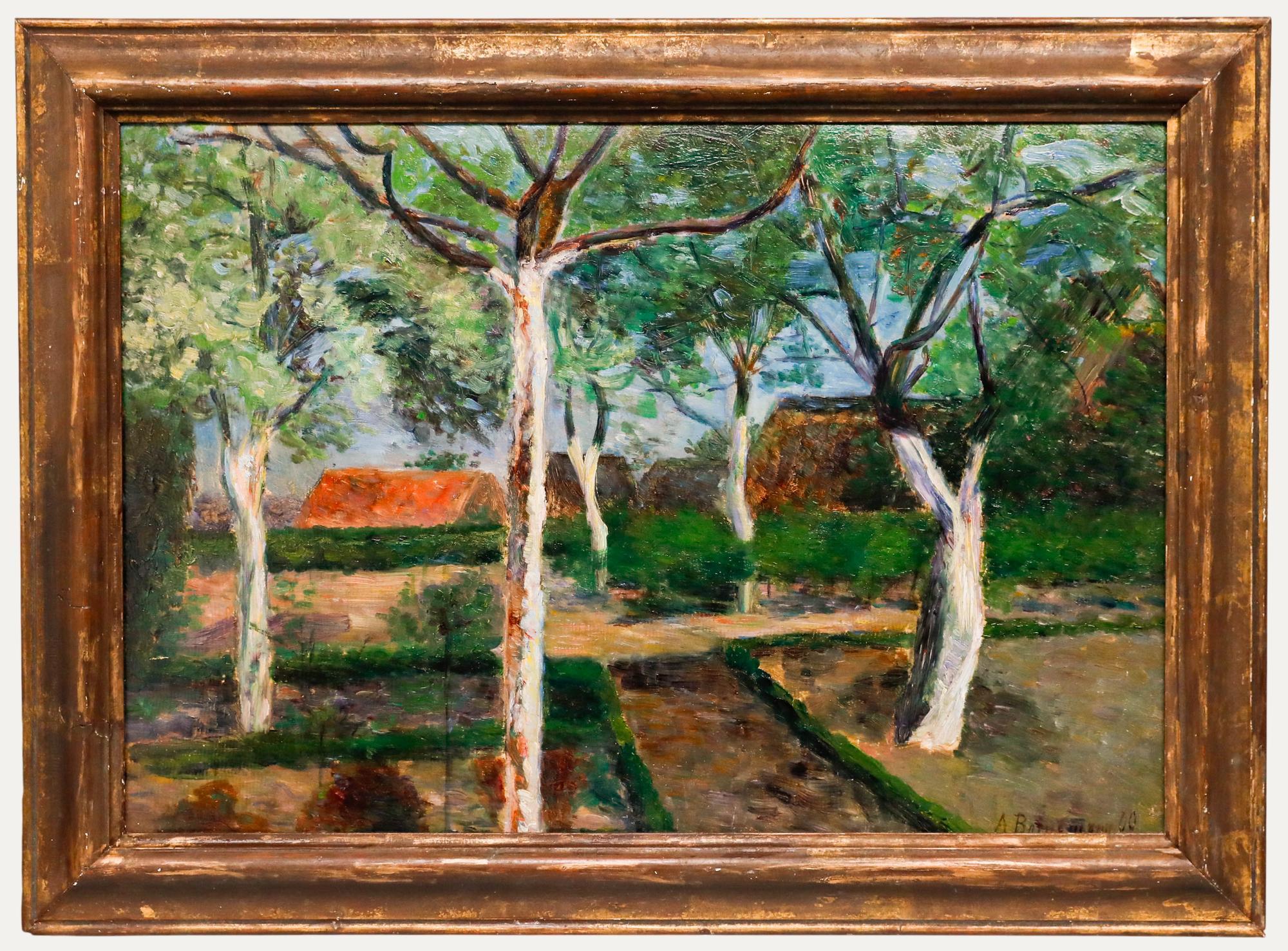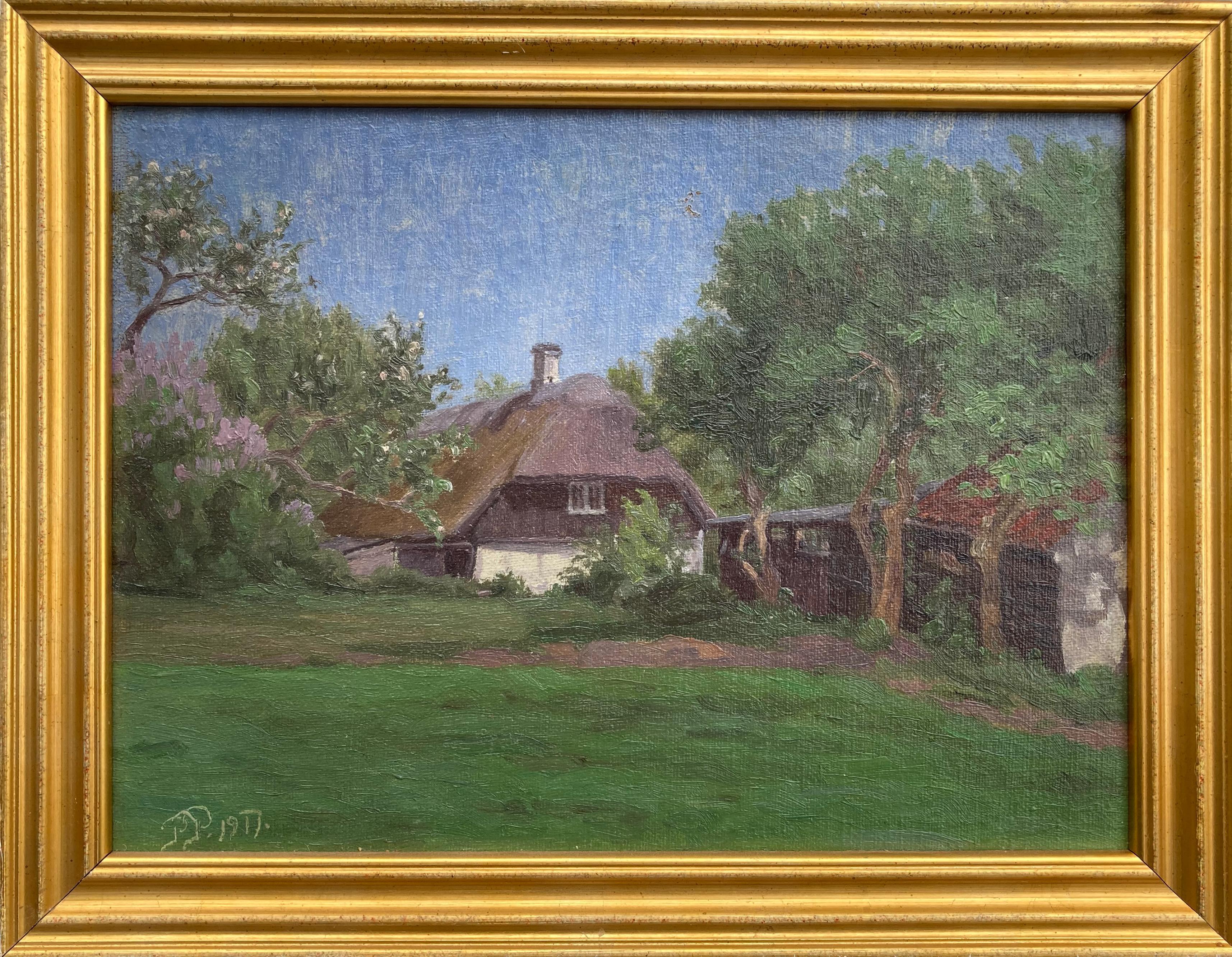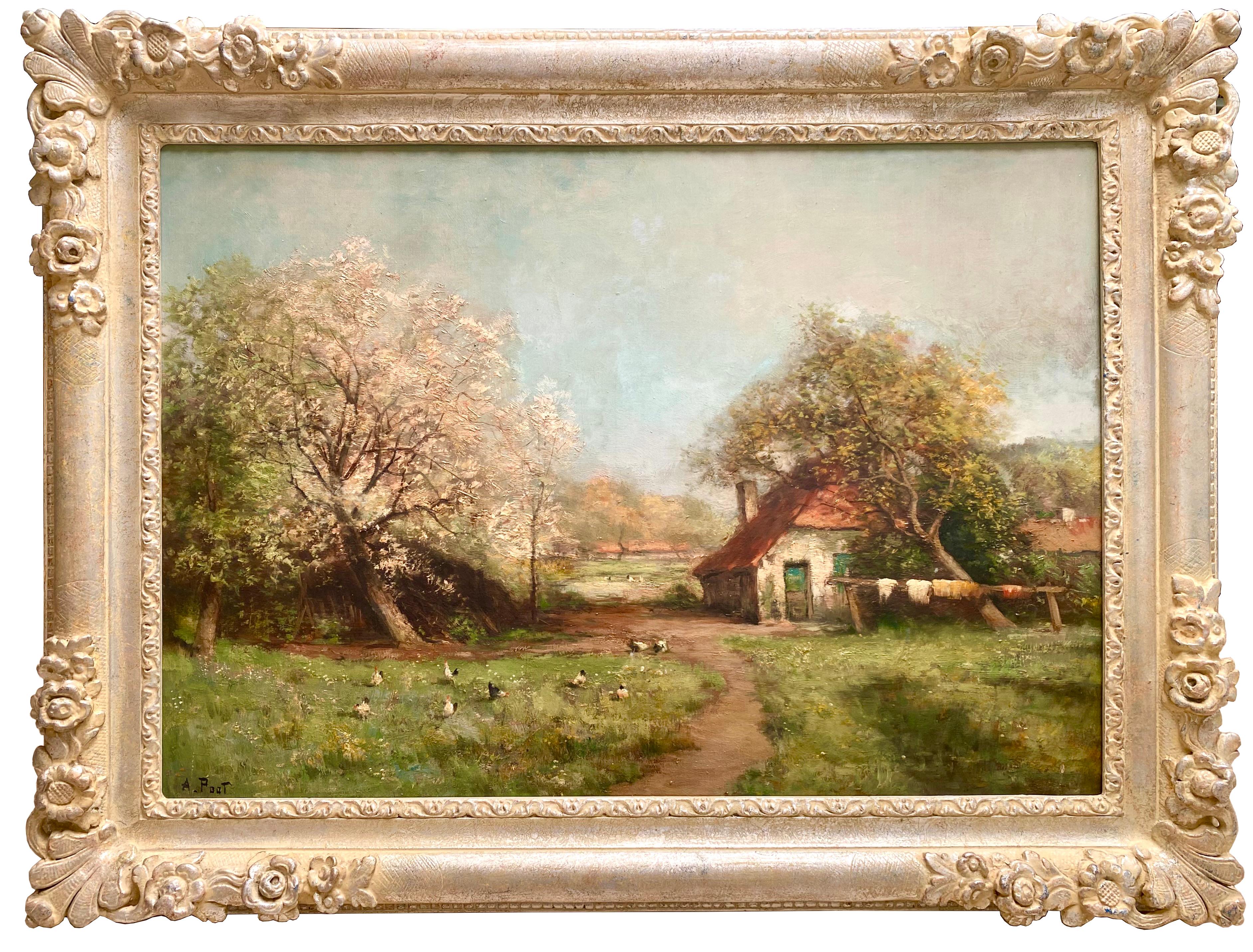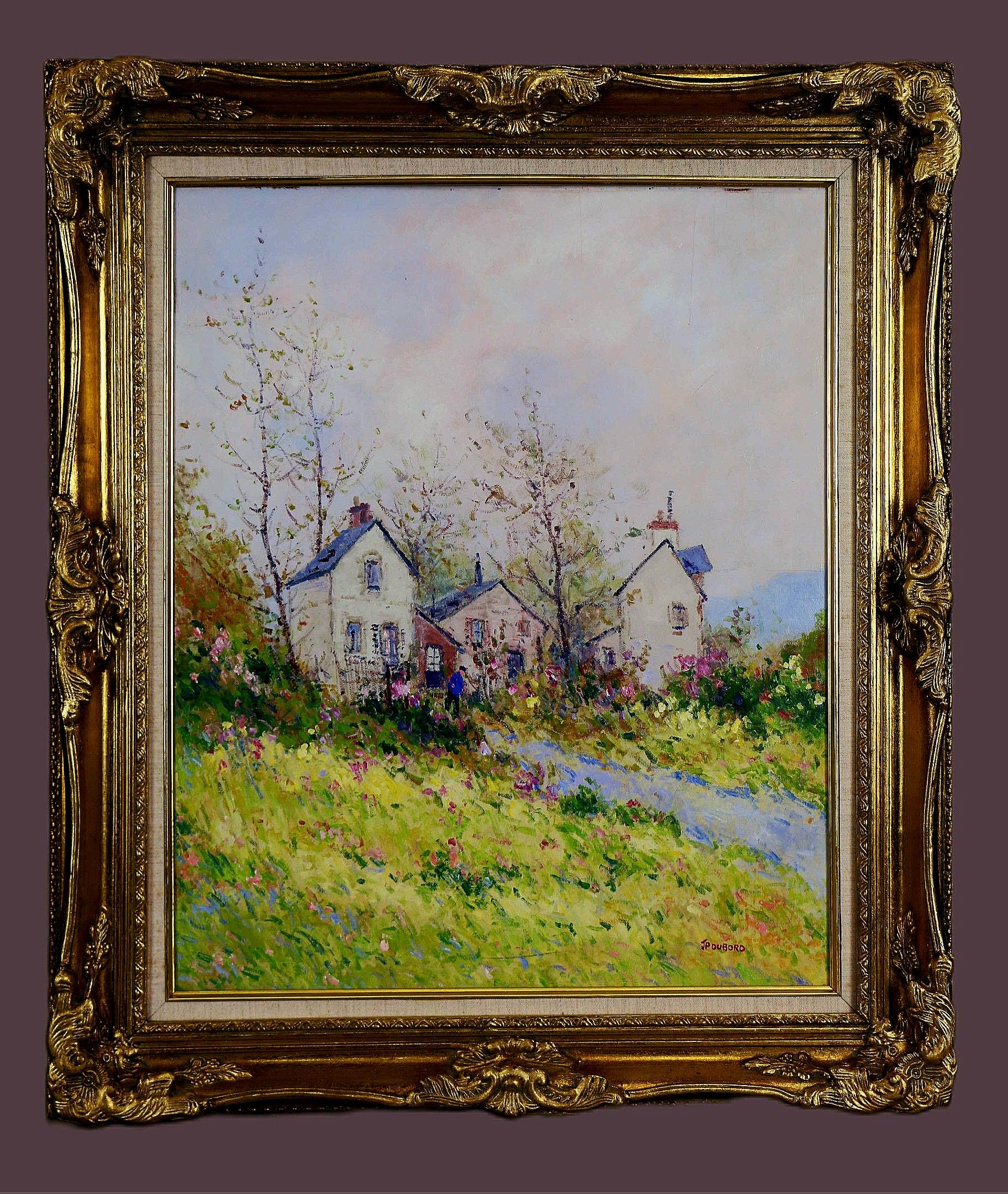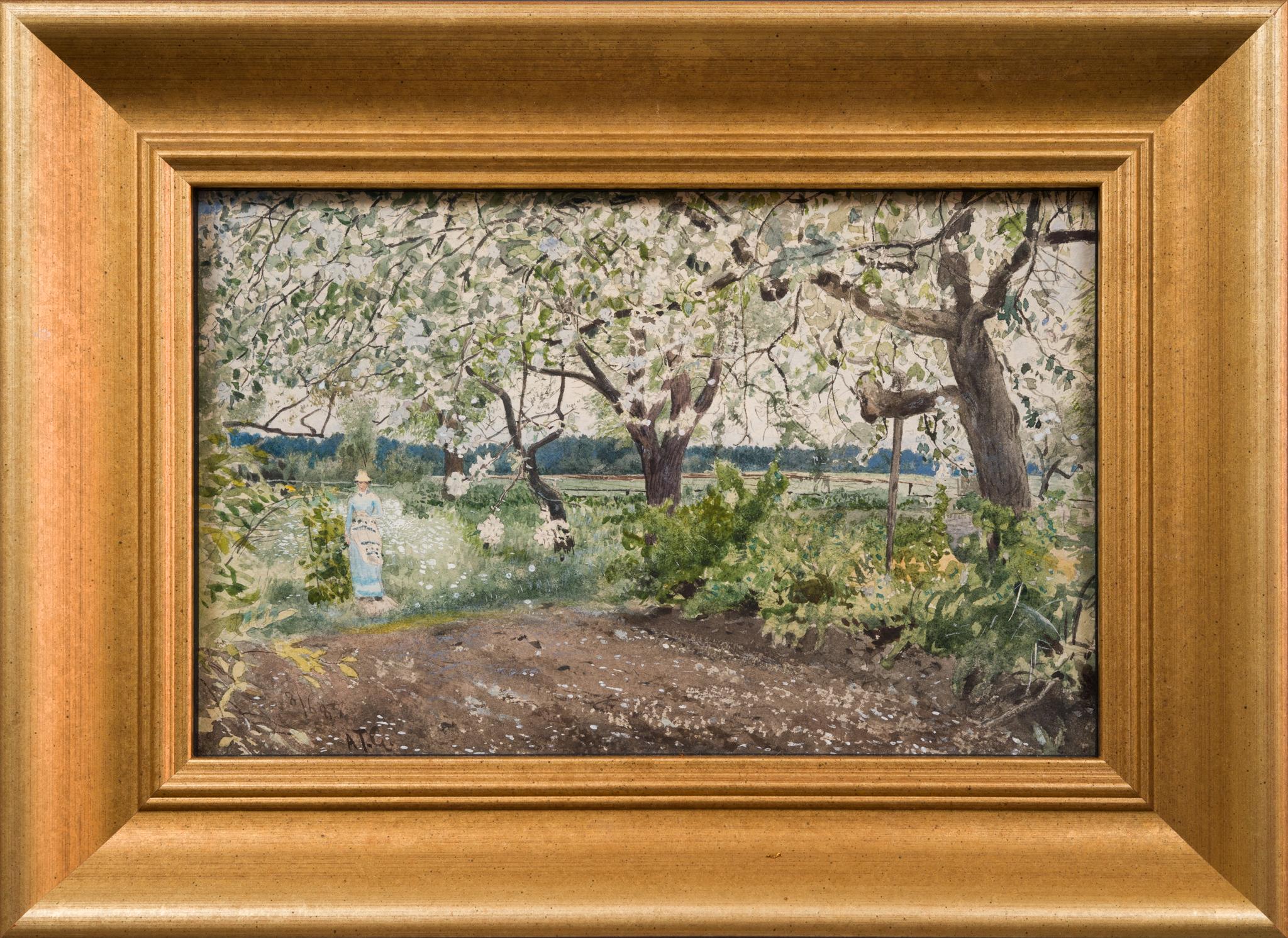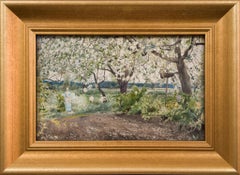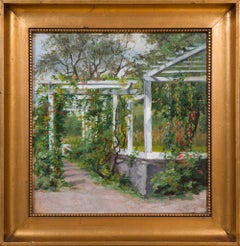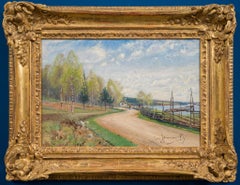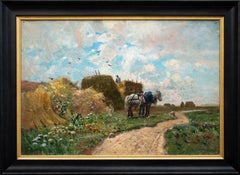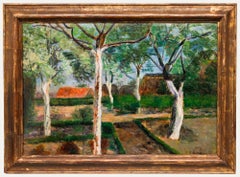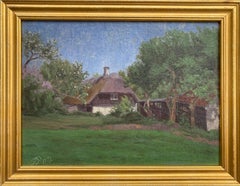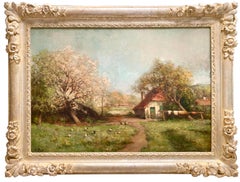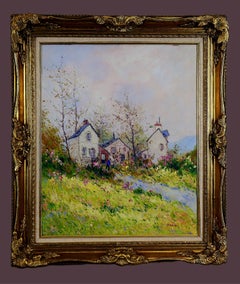Items Similar to Garden with Blooming Chestnut Trees, France
Want more images or videos?
Request additional images or videos from the seller
1 of 9
Carl SkånbergGarden with Blooming Chestnut Trees, France1875
1875
$4,652.56
£3,439.25
€3,900
CA$6,453.34
A$7,035.55
CHF 3,717.45
MX$86,520.68
NOK 46,223.47
SEK 43,513.27
DKK 29,696.49
About the Item
Viggo Loos lists the painting under works from 1875 as a "Skåne farmstead," but this is likely incorrect. Skånberg was in France at that time. In this composition, he incorporates a blooming chestnut tree with red blossoms, indicating it is a sweet chestnut, a species found in France whose nuts are edible. This contrasts with the horse chestnut, more common in Sweden, with white blossoms and toxic nuts. Chestnut trees were exceedingly rare in Sweden at the time. In the 1860s, Olof Eneroth reported in Handbook of Swedish Pomology (1864–66) that chestnut trees at estates in Skåne—Tosterup, Rydsgård, and Vrams Gunnarstorp—bore fruit in warm summers. Alexandra Smirnoff, in a 1902 reissue of Eneroth’s book, described a young chestnut tree at Vibyholm in Södermanland yielding ripe fruit in 1873, which caused a sensation when exhibited in Vienna.
Two other paintings by Skånberg with similar motifs are known, both created in France in 1875–76: Garden Interior from Aumont [-en-Halatte], stamp-signed, 29 x 41 cm, formerly in the Conrad Pineus collection, Gothenburg (exhibition catalogue, Norrköping Museum, Carl Skånberg Memorial Exhibition, September 28–October 31, 1946, no. 50) and French Farmstead, stamp-signed, 24 x 32 cm, previously in Axel Gauffin's collection (op. cit., no. 51). These works collectively support the conclusion that this painting was created in France.
Skånberg, a known pipe smoker, may have depicted the pipe-smoking man in the painting as a signature element.
Carl Skånberg was a pivotal figure in the breakthrough of Swedish plein-air painting. His free-spirited approach and radicalism place him alongside the early French Impressionists. Richard Bergh considered him instrumental in advancing the modern and radical direction in Swedish landscape painting. Georg Nordensvan wrote in Stockholms Dagblad, in conjunction with the Swedish Painting 1800–1885 exhibition at Liljevalchs in 1921:
"The journey [in landscape painting] goes from Fahlcrantz to Skånberg and Hill, from studio compositions to direct nature studies, from dusk to light and air..."
After completing his studies at the Royal Academy of Fine Arts, Skånberg traveled to Paris in the summer of 1875, continuing to Barbizon in the fall. The French landscape painting associated with Barbizon and the Fontainebleau Forest had influenced Alfred Wahlberg, and Skånberg worked there on a large canvas, Interior of Fontainebleau Forest, intended for the 1876 Philadelphia World’s Fair. When later exhibited at the Royal Academy in Stockholm, August Strindberg praised it for capturing the density of greenery and sunlight filtering through the canopy without succumbing to "mood painting" (a term then used to criticize works lacking focus on composition, shadows, or spatial depth).
In Paris, Skånberg became the centerpiece of the Swedish artistic community. In 1878, Carl Larsson painted his portrait, and in 1880, Ernst Josephson created a well-known full-length portrait capturing Skånberg’s witty, sharp demeanor and self-confident presence. Skånberg was short, hunchbacked since childhood, and, in his own words, "hardly an Adonis."
In early 1881, Skånberg traveled to Italy seeking relief from asthma, visiting Sicily, Venice, and Rome. In Venice, he painted one of his finest works, The Grand Canal, noted for its bold composition and gray-blue color palette, effectively evoking the rainy atmosphere of the city. The painting, gifted to Ernst Josephson and later donated to the National Museum, represents a culmination of his artistic maturity.
In Italy, Skånberg also met his future wife, Ellen Hintze, in the Scandinavian Association in Rome. They married in the spring of 1882 at the Swedish Consulate in Rome, with a festive reception attended by figures such as Henrik Ibsen. Skånberg’s health deteriorated in late 1882, and he returned to Stockholm, where he passed away shortly thereafter. Ellen remarried Sven Oskar Alexander Gyllensvärd and inherited Skånberg’s estate. Many of his unsigned works were subsequently stamped with his signature.
Skånberg was a trailblazer in Swedish plein-air painting. While some have noted Impressionistic tendencies in his work, there is no evidence he was deeply familiar with the Impressionists' methods or intentions; the similarities are more coincidental. Though he enjoyed some success during his lifetime, his true breakthrough came posthumously. A memorial exhibition featuring around 100 works brought widespread attention to his art, and several of his pieces were included in the Opponent Movement’s landmark 1885 exhibition.
During his short life, Skånberg achieved his greatest acclaim with The Harbor of Dordrecht, exhibited at the Paris Salon in 1880 and the 1881 Scandinavian Exhibition in Gothenburg. Purchased by Pontus Fürstenberg, the work is now housed in the Gothenburg Museum of Art.
Stamp-signed “CARL SKÅNBERG”
painted 1875
oil on canvas
unframed: 45.5 x 72.6 cm (17 7/8 x 28 5/8 in)
framed: 66 x 93.5 cm (26 x 36 3/4 in)
The original gilded and ornamented frame with old patina is included.
Provenance:
Mrs. Ellen Skånberg (1861–1950), née Hintze, later married to Gyllensvärd;
Director Per Gabriel Palmquist (1865–1949), Stockholm
Literature:
V. Loos, Carl Skånberg – His Life and Work, Östgöta Art Association Publication, 1928, pp. 241–42, listed under 1875, no. 87, as “Farmstead. The painting depicts a Skåne farmstead with gray lime-washed buildings. By a stone wall, there are figures—a man smoking a pipe and a woman wearing a kerchief. The light green vegetation in the foreground is meticulously detailed. A large tree with a vast crown and red blossoms is silhouetted against the gray sky. In the foreground, there is a blooming rose bush.”
- Creator:Carl Skånberg (1850 - 1883, Swedish)
- Creation Year:1875
- Dimensions:Height: 25.99 in (66 cm)Width: 36.62 in (93 cm)
- Medium:
- Movement & Style:
- Period:
- Condition:Recently restored by a professional art conservator. The original frame has an aged patina. When shipping this type of frame, there is always a risk that some parts may come loose and require re-gluing. The buyer should be aware of this.
- Gallery Location:Stockholm, SE
- Reference Number:1stDibs: LU1445215599462
About the Seller
5.0
Platinum Seller
Premium sellers with a 4.7+ rating and 24-hour response times
Established in 2020
1stDibs seller since 2020
198 sales on 1stDibs
Typical response time: <1 hour
Associations
International Confederation of Art and Antique Dealers' Associations
- ShippingRetrieving quote...Shipping from: Stockholm, Sweden
- Return Policy
Authenticity Guarantee
In the unlikely event there’s an issue with an item’s authenticity, contact us within 1 year for a full refund. DetailsMoney-Back Guarantee
If your item is not as described, is damaged in transit, or does not arrive, contact us within 7 days for a full refund. Details24-Hour Cancellation
You have a 24-hour grace period in which to reconsider your purchase, with no questions asked.Vetted Professional Sellers
Our world-class sellers must adhere to strict standards for service and quality, maintaining the integrity of our listings.Price-Match Guarantee
If you find that a seller listed the same item for a lower price elsewhere, we’ll match it.Trusted Global Delivery
Our best-in-class carrier network provides specialized shipping options worldwide, including custom delivery.More From This Seller
View AllWatercolor The Garden at Sickelsjö, 1883
Located in Stockholm, SE
We are delighted to present a stunning watercolor by the Swedish artist Albert Theodor Gellerstedt. This artwork, titled "Sickelsjö Trädgård" was created on June 8, 1883. The paintin...
Category
1880s Romantic Landscape Drawings and Watercolors
Materials
Paper, Watercolor
Garden Scene Called Pergola Noor by Female Artist Clara Löfgren
Located in Stockholm, SE
Clara Löfgren (1843–1923) Sweden
Pergola Noor, c.1890
oil on canvas laid down on board
no signature
unframed: 27.7 x 26.7 cm (10.9 x 10.5 in)
framed: 35 x 34 cm (13.8 x 13.4 in)
P...
Category
1890s Realist Landscape Paintings
Materials
Canvas, Oil, Board
Impressionistic Summer Landscape with Road Painted 1889
Located in Stockholm, SE
Carl Johansson's "Summer Landscape with Road" is an exquisite landscape that encapsulates the serene beauty of the Swedish countryside. Painted in 1889, the same year Johansson showcased his work at the Exposition Universelle in Paris, one can't help but wonder if this very painting was among those displayed at the fair.
"Summer Landscape with Road" offers a glimpse into the idyllic Swedish countryside through its masterful depiction. The scene is bathed in the distinctive light of the sun positioned at 30 degrees north-northwest, a unique aspect of Johansson's artworks. The viewer's eye is drawn along a winding dirt road that meanders through a tranquil pastoral landscape. Birch trees, with their white bark and tender green leaves, stand tall and sway gently, marking the passage toward a distant homestead nestled beside a calm lake. The rustic wooden fences and the clear sky, dotted with soft, billowing clouds, evoke a sense of peaceful solitude.
Johansson's meticulous attention to detail and colour is evident in every brushstroke, from the lush greenery to the soft, earthy path leading to the horizon. The artist's signature use of light not only highlights the natural beauty of the North but also enhances the sense of depth and realism in the painting.
Johansson's early works, such as this one, are exceedingly rare, making "Summer Landscape with Road" not only a visual delight but also a collector's gem. The painting's magnificent gold frame enhances the bright, vivid colours of the small-format artwork, creating an impactful presence.
Carl Johansson's blue impressionistic depictions of Northern Sweden earned him the nickname "Ultramarine Johansson", and his paintings are celebrated in prestigious collections, including the Nationalmuseum in Stockholm, Kalmar Art Museum, and the municipality of Hudiksvall.
oil on canvas
signed and dated Carl Johansson . 89 .
unframed 27 x 39 cm
framed 41,5 x 53 cm
Provenance:
The previous owner bought it in 1988 at Åmells Stockholm...
Category
1880s Impressionist Landscape Paintings
Materials
Canvas, Oil
Harvest Time by Hjalmar Sandberg, Swedish Artist, Oil on Canvas, Signed, 1876
Located in Stockholm, SE
Hjalmar Sandberg (1847-1888) Sweden
Harvest Time, 1876
oil on canvas
canvas size 14.96 x 18.11 inches (38 x 46 cm)
frame 18.70 x 25.59 inches (47.5 ...
Category
1870s Impressionist Landscape Paintings
Materials
Canvas, Oil
Original Oil Paining, A Landscape View, 1927, Most likely from Nordingrå, Sweden
Located in Stockholm, SE
Carl Johansson's painting from 1927, most likely depicting a view from Nordingrå, encapsulates the serene beauty of the northern Swedish landscape. Born in Härnösand, Johansson drew ...
Category
1920s Post-Impressionist Landscape Paintings
Materials
Oil, Wood Panel
Original Oil Painting Depicting a Farmstead in Dalarna, Sweden, 1864
Located in Stockholm, SE
Olof Arborelius (1842–1915) Sweden
Farmstead in Dalarna, 1864
signed with monogram OA and dated “Arb-s 64” inscribed into the wet paint, with the estate’s stamp "OA" on the back.
o...
Category
1860s Impressionist Landscape Paintings
Materials
Oil, Board, Laid Paper
You May Also Like
Anna Bornemann (1874-1956) - 1900 Oil, A View of the Garden
Located in Corsham, GB
This delightful turn of the century landscape by the artist Anna Bornemann (1874-1956) depicts a serene garden scene featuring several skeletal trees with silvery bark set against a ...
Category
Early 20th Century Landscape Paintings
Materials
Oil
"Summer Cottage" - Framed Early 20th Century Landscape Painting
Located in New Orleans, LA
Doesn't this scene just make you want to be there, in this cottage in the country? I liked this painting enough that I actually put some money into it with a restorer to get it into ...
Category
1910s Impressionist Landscape Paintings
Materials
Oil
'Farmhous in Spring' by Adolphe Poot ( 1924 – 2006 ) Belgian Painter
Located in Knokke, BE
Adolphe Poot
1924 – 2006
Belgian Painter
'Farmhous in Spring'
Signature: signed lower left ‘ A. Poot’
Medium: oil on canvas
Dimensions: image size 73,5 x 100,5 cm, frame size 93 ...
Category
Mid-20th Century Impressionist Landscape Paintings
Materials
Canvas, Oil
Dubord Jean. Landscape In A Flower Garden In Autumn - oil on canvas - signed.
Located in PARIS, FR
Excellent condition. Never restored. Dimensions with frame 68 x 78 cm
Jean Pierre Dubord was born in Rouen in 1949, and after spending years in the French countryside, he returned t...
Category
Late 20th Century Post-Impressionist Landscape Paintings
Materials
Oil
Nils Hans Christiansen (1850-1922) - Oil, Scandinavian Farmstead in Summer
By Nils Hans Christiansen
Located in Corsham, GB
A charming oil depiction of a Scandinavian Farmstead in high summer. Chicken roam by a small stream and cattle graze in distant fields. there artist captures the soft summer light hi...
Category
Early 20th Century Landscape Paintings
Materials
Oil
Antique Oil Painting, Summer Garden with Flowers.
Located in Berlin, DE
Antique oil painting, summer garden with flowers
Age-related condition.
Dimensions without frame.
Oswald von Krobshofer was from 14 November 1903 pupil at the Academy of Fine Arts in Munich under Carl von Marr, Peter Halm and Julius Exter. He worked as an artist in Munich, Berlin, Naumburg, Leipzig and Miltitz near Leipzig. He was a member of the German Kunstgenossenschaft and the Metznerbund Tetschen. With landscape and figure pictures he was represented 1911-1914 in the Munich secession. In 1913 he had an exhibition in the Vienna Secession, with etchings he was represented in 1921 in the Dresden Art...
Category
20th Century Landscape Paintings
Materials
Oil, Cardboard
$1,908 Sale Price
20% Off
More Ways To Browse
1921 Painting
Antique Smoking Pipe
Antique Smoker
Stone Figures
Smoking Man
Chestnut Horse
Lime Washed
French Landscape 1870
Swedish Air
Alfred Wahlberg
Paintings Of Lavender
Roma Oil Paintings
Venice San Giorgio
Vintage Barn Signs
Vintage Mathews
Virginia Landscape Oil Painting
Volcano Painting
19th Century American Artists
